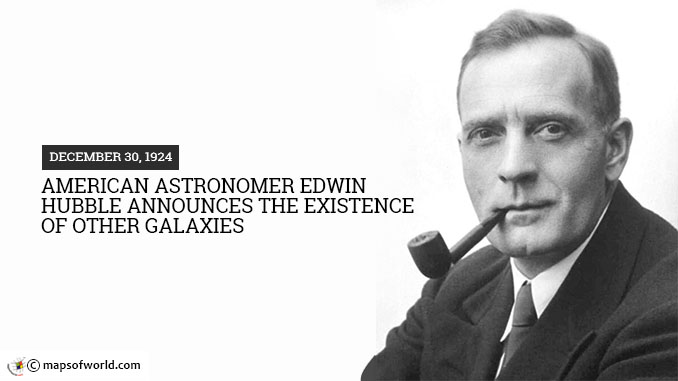Working from the Mount Wilson Observatory 20 miles to the northeast of Los Angeles, astronomer Edwin Hubble revealed stunning findings on December 30, 1924: the Milky Way Galaxy was not the only one in the universe. Using a 100-inch telescope and a decade-old method for determining the distance a star was from Earth, Hubble shattered the world’s understanding of the cosmos. Growing up in Louisville, Kentucky, Hubble had a reputation for being a fantastic athlete. When he moved up to the University of Chicago after graduating high school, he excelled academically — so much so he received a Rhodes scholarship to Oxford, where he earned a master’s degree in jurisprudence. He returned from England in 1913 and set up a law practice in his hometown of Louisville, teaching and coaching basketball at a nearby high school across the Ohio River in Indiana. Tapping into a fascination with science he gained from reading the works of Jules Verne as a child, he would ultimately earn a PhD in astronomy from the University of Chicago in 1917. Within months, he was called to fight in World War I by the US Army, putting his astronomy career on hold for two years. Receiving an honorable discharge after attaining the rank of major, Hubble moved to California in 1919 to work with George Ellery Hale — one of the world’s foremost astronomers at the time — at the Mount Wilson Observatory. Funded by the Carnegie Institution, Hale managed to design and build the 100-inch Hooker telescope — the largest on the planet until 1948 — for Mount Wilson. Thanks to its hilltop location far outside the bright lights of Los Angeles in the Angeles National Forest, views of the night sky were nearly perfect. Taking advantage of the magnificent clarity the state-of-the-art telescope provided, Hubble focused on the Andromeda Nebula. Prevailing wisdom in the scientific community up until the 1920s was the measurements of the Milky Way Galaxy amounted to the boundaries of the universe. The wispy spiral nebulae in the distance were nothing more than swirling gasses writhing against the darkness of deep space. Just twelve years before, Henrietta Leavitt realized the flickering pattern of a star could be used to calculate how far it was from Earth. As Hubble noted the bright-dark-bright cycle of the stars in Andromeda, he estimated they were some 860,000 light years away — far beyond the edge of the Milky Way just 100,000 light years in the distance. Hubble theorized Andromeda was actually a galaxy unto itself and not a nebula at all. On December 30, 1924, Hubble published his observations for review at a meeting of the American Astronomical Society coming up two days later. More-tenured astronomers were having fits — there was no way Hubble could be correct, so far as they believed. When he appeared at the conference, his results were staggering: the Milky Way undoubtedly had company in the universe. During the next three decades, Hubble would become one of the best-known astronomers in history. In 1926, he revealed a system for classifying galaxies still in use. Three years later, he proved the light put off by distant objects would shift more toward the red end of the spectrum the farther away they were, giving scientists a better understanding of the age and growth of the universe. (Observations along these lines had been forwarded by Georges Lemaitre to propose the Big Bang Theory.) Four years after being the first astronomer to take observations at the Mount Palomar Observatory in 1949 — using a telescope twice the size of the one at Mount Wilson — Hubble died suddenly with a blood clot in his brain on September 28, 1953. As a testament to the legacy he created by looking toward the heavens, NASA launched the Hubble Space Telescope in April 1990, which hangs in low Earth orbit taking photographs of far-off galaxies to this day. Also On This Day: 1066- Muslims in Granada, Spain crucify Joseph ibn Naghrela and massacre the city’s Jewish population 1460 – King Henry Vi defeats Richard, Duke of York at the Battle of Wakefield during the War of the Roses 1927 – The first subway in Asia, the Ginza Line, opens in Tokyo 1947 – King Michael of Romania is forced to step down in favor of a new Communist government 1972 – The United States brings heavy bombing of North Vietnam to an end
December 30 1924 – American Astronomer Edwin Hubble Announces the Existence of Other Galaxies
Working from the Mount Wilson Observatory 20 miles to the northeast of Los Angeles, astronomer Edwin Hubble revealed stunning findings on December 30, 1924: the Milky Way Galaxy was not…
642
